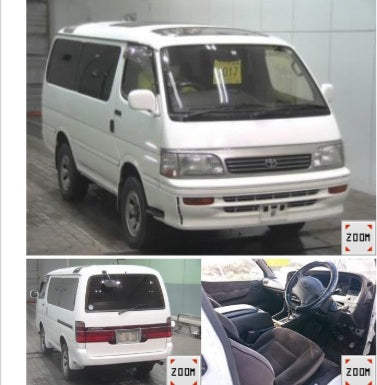Just came in a TRUE OFF ROAD Legend 89 JDM Mitsubishi Pajero 4x4 Diesel Manual with just under 64k miles(Verified Miles).
2.5L(4D56T) Turbo Diesel engine with 63k miles, 5 Speed manual transmission with 4lo/4hi. Clutch feels like new, brakes work great, 4 wheel drive hooks, everything works. Just crazy for a old vehicle like this, but what can you say for a japenese vehicle that has been well taken care of.
This classic beast is real clean and well taken care of(someone in japan really loved this thing), In 4lo this things climbs almost anything and with a factory winch you can almost go anywhere. Body and interior are in great condition. Runs and drives great, really solid truck, no shakes or rattles like other older trucks. The driver seat has it own suspension like a tractor trailer and fully adjustable, feels like driving a big rig.
Only flaws are some wear on driver seat, small burn spot on rear seat, small scratch on driver door and 2 small rust spots as pictured. Front vent windows metal trim has some surface rust as pictured
Contact Rob 864-505-5621
Competition history
In January 1983, the first Pajero Evolution debuted at the Paris Dakar Rally, taking first place in 1985 at only the third attempt. Other wins followed, at events such as the Australasian Safari and Northern Forest.
With 12 victories from 1985 to 2007, it is the car that has won the Dakar Rally the most times.
The first generation made its debut at the Tokyo Motor Show in October 1981, and was launched in May 1982, officially replacing the Mitsubishi Jeep Delivery Wagon. Initially, it was a three-door, short-wheelbase model available with a metal or canvas top and three different engines options, although more were gradually added, ending with a 3.0-litre V6 on top of the range
It included features which were unusual for a four-wheel-drive vehicle: a turbocharged diesel engine, a front double wishbone suspension with torsion bar springs, power steering and suspension seats.
In January 1983, only a year following its launch, mildly tuned production Pajeros entered the world of motor sport.
In February 1983, Mitsubishi introduced a long-wheelbase, five-door model, available with a choice of two different engines; a 2.0-litre turbocharged petrol (badged as "2.0 Turbo" and "2000 Turbo" in some markets) and a 2.3-litre turbocharged diesel. It also came in Standard, Semi-High Roof and High Roof body styles. Outside of Japan there was also the 2.6-liter petrol four, which produced 103 PS (76 kW) in European trim.[14]
The long-wheelbase model increased seating capacity to seven, with available third row seats, which could be folded to the sides for additional trunk space or combined with second row seats to form a bed.
In 1984, the Pajero received turbo diesel engines with higher power/torque ratings, whilst the long-wheelbase models received standard four-wheel disc brakes and four-way adjustable shock absorbers as standard equipment.
In 1984, the Pajero received turbo diesel engines with higher power/torque ratings, whilst the long-wheelbase models received standard four-wheel disc brakes and four-way adjustable shock absorbers as standard equipment.
A flagship model was introduced in 1987 with two-tone paint, 15-inch light alloy wheels, front-seat heaters, wool seat covers, leather headrests, a three-spoke steering wheel and a sound system with radio/cassette. In 1987, a version of the Pajero/Montero was rebadged by Dodge as the Raider, which ran through 1989.
In 1988, a 3.0-litre SOHC V6 engine was made available, alongside a 2.5-litre turbo diesel engine, with the first 4x4 intercooler. The long-wheelbase models received a coil link suspension system for better ride comfort and off-road ability.
It was available with a 3-door body for a short wheelbase (SWB) or a 5-door body for a long-wheelbase (LWB). Engines included a 2.6 L I4 with 82 kW (111 PS; 110 hp), a 3.0 L V6 with EFI and 104 kW (141 PS; 139 hp) and a turbocharged 2.5 L OHC diesel I4 with 62 kW (84 PS; 83 hp) or an intercooled 70 kW (95 PS; 94 hp). Part-time four-wheel drive was standard on all models.
The first generation platform was later built under license by Hyundai Precision Products as the Hyundai Galloper from 1991 to 2003, and exported to Europe for a brief time. While it used first generation mechanicals, the Galloper's body was closer to the second generation Pajeros.





































































